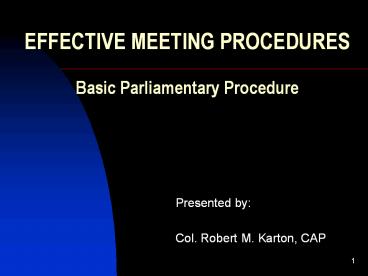EFFECTIVE MEETING PROCEDURES Basic Parliamentary Procedure - PowerPoint PPT Presentation
1 / 12
Title: EFFECTIVE MEETING PROCEDURES Basic Parliamentary Procedure
1
EFFECTIVE MEETING PROCEDURESBasic Parliamentary
Procedure
- Presented by
- Col. Robert M. Karton, CAP
2
RULES OF ORDER
- Intended to
- 1) Facilitate, not Obstruct
- 2) Permit Majority Rule while
- ensuring the right of the
- minority to be heard
3
GENERAL RULES
- 1) No one may speak without being first
recognized by the chair not the person holding
the floor. - 2) Statements, questions, etc., are directed to
the chair. - 3) One person speaks at a time.
- 4) No person may speak more than once on an
issue, except the chair, until all other persons
have had an opportunity to speak once. - 5) A person is out of order when he/she starts
to make a speech without being recognized by the
chair. - 6) Remarks are out of order when they are
insulting, profane, or otherwise offend decency.
4
MOTIONS IN GENERAL
- 1) Most motions may not be made if another
has the floor. Motions to raise a question of
privilege, raise a question of parliamentary
inquiry, appeal a decision of the chair and raise
a point of order are the principal exceptions. - 2) Motions must be offered by a member of the
National Board with voting power and then
seconded by another voting member of the National
Board. If a motion does not receive a second, it
fails. - 3) A committee recommendation or request for
action has no automatic status as a motion. It,
like other motions, must be offered as a motion
by a voting member of the National Board and must
be seconded by another voting member of the
National Board. Without a motion and a second,
the recommendation or request simply dies or
fails.
5
QUESTION OF PRIVILEGE
- 1) Relates to rights and comfort of the assembly
as a whole or of any member. - 2) May be of sufficient urgency to interrupt
another who has the floor (urgency decided by the
chair) - 3) Does not require a second Is not debatable
Is not amendable. - 4) Is granted or denied by the chair there is
not vote unless the decision of the chair is
appealed.
6
POINT OF ORDER
- 1) Questions a decision by the chair.
- 2) Must be raised immediately after the alleged
error (except in the case of a clear violation of
the Constitution or By-Laws. - 3) May interrupt another who has the floor.
- 4) Does not require a second Is not debatable
Is not amendable. - 5) Is well taken or not well taken by
decision of the chair there is no vote unless
decision of the chair is appealed.
7
POINT OF INFORMATION(Point of Parliamentary
Inquiry)
- 1) Must relate to pending business.
- 2) May interrupt another who has the floor (but,
if abusive, may be ruled out of order). - 3) Does not require a second Is not debatable
Is not amendable. - 4) Is answered by the chair.
- 5) Is not appealable.
8
APPEAL DECISION OF THE CHAIR
- 1) Any decision may be appealed.
- 2) May interrupt another who has the floor.
- 3) Is out of order if not made immediately after
decision appealed. - 4) Requires a second.
- 5) If debatable, it is subject to motions to
table and to close debate. - 6) Not debatable if motion pending is not
debatable or if ruling relates only to decorum,
violation of rules or order of business. - 7) Is not amendable may not be renewed.
- 8) Requires simple majority.
9
MOTION TO TABLE
- 1) Deals with temporary interruptions.
- 2) Applies to main question, appeals, votes
on questions of privilege and reconsideration. - 3) May not interrupt another who has the floor
(movant must be recognized). - 4) Requires a second.
- 5) Is not debatable Is not amendable.
- 6) Requires a simple majority.
10
MOTION TO POSTPONE
- 1) May be to a date certain or indefinitely.
- 2) Movant must be recognized.
- 3) Reqires a second.
- 4) Is debatable, including debate on the motion
sought to be postponed. - 5) Reqires a simple majority.
11
MOTION TO CALL THE PREVIOUS QUESTION(Call the
Question)(Close Debate)
- Applies to any debatable motion.
- May not interrupt another who has the floor
(movant must be recognized). - Requires a second.
- Is not debatable Is not amendable.
- Requires 2/3 majority.
- Motion to limit debate (to end debate after a
predetermined amount of time or at a
predetermined time) is substantially the same as
a motion to call the previous question except it
may be amended and it is debatable.
12
MOTION TO TAKE FROM THE TABLE
- 1) Applies only to motion which was tabled.
- 2) May be made any time after motion to which it
relates was tabled. - 3) May not interrupt another who has the floor
(movant must be recognized). - 4) Requires a second.
- 5) Is not debatable Is not amendable.
- 6) Requires a simple majority.































